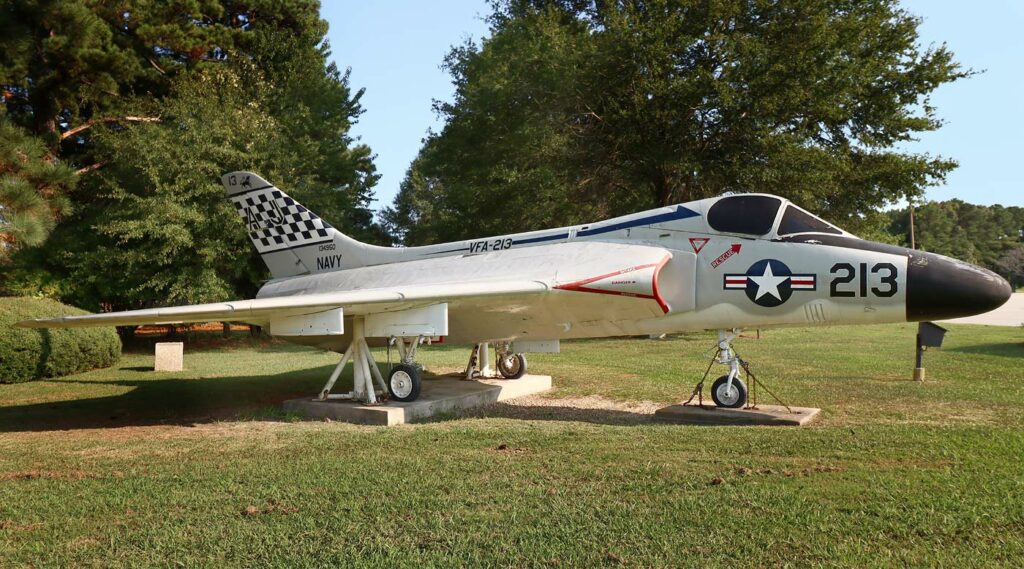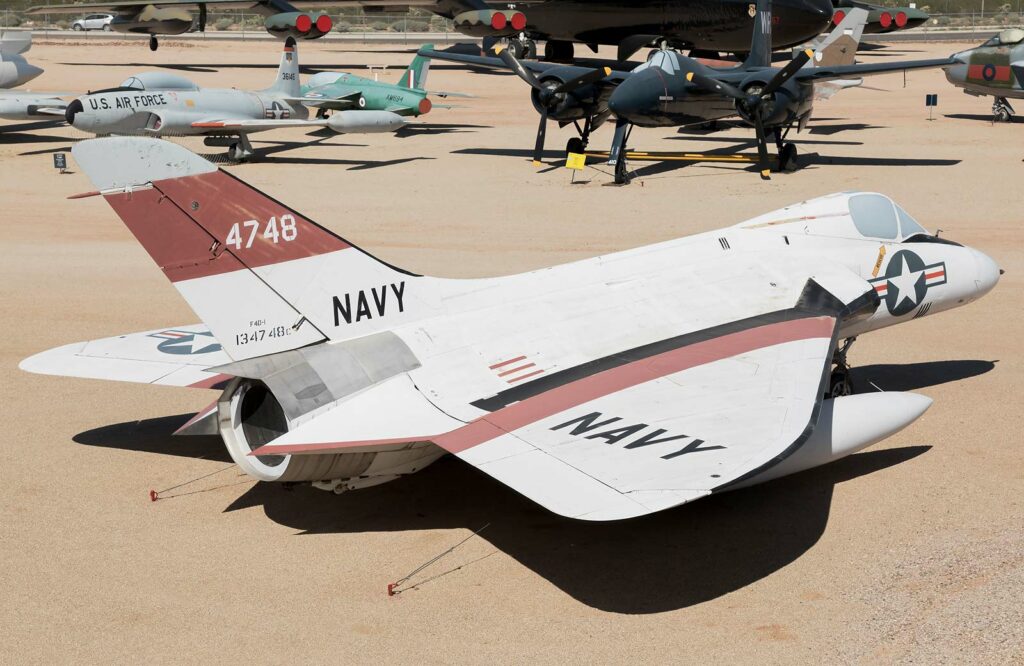The Douglas F4D / F-6 Skyray was a high-performance, delta-winged interceptor aircraft designed for the U.S. Navy.
In Brief
The Douglas F4D / F-6 Skyray, developed by Douglas Aircraft Company, was a carrier-based interceptor aircraft. Powered by a Pratt & Whitney J57-P-8B turbojet engine producing 14,500 lb of thrust, it achieved a maximum speed of 722 mph and a service ceiling of 55,003 ft. The Skyray had a length of 13.93 meters, a wingspan of 10.21 meters, and a height of 3.96 meters. It featured a wide delta wing design, thick wing roots containing air intakes, and a taileron control system. The F4D / F-6 was armed with 4 × 20 mm cannons and had a maximum takeoff weight of 25,000 lb. It set numerous records, including a time-to-altitude record of 49,221 feet in 2 minutes and 36 seconds.
The Douglas F4D / F-6 Skyray played a significant role in the evolution of naval aviation during the Cold War era. As a dedicated high-altitude interceptor, the Skyray was notable for its distinctive delta-wing design and exceptional performance characteristics.

History of the Development of the Douglas F4D / F-6 Skyray
The development of the Douglas F4D / F-6 Skyray began in 1947 to meet the United States Navy’s requirement for a high-performance, all-weather interceptor capable of rapid climb to high altitudes. Designed by Ed Heinemann, the Skyray was influenced by the delta-wing research of German aeronautical engineer Alexander Lippisch. The F4D Skyray was powered by the Westinghouse J40 turbojet engine, but due to issues with this engine, it was eventually equipped with the more powerful Pratt & Whitney J57.
The first prototype of the Skyray flew in January 1951, and subsequent testing and development led to several redesigns to improve its performance. The aircraft encountered challenges, such as a high-speed stall issue, which delayed its introduction into service. The first production F4D-1 set a new standard in speed, becoming the first aircraft to sustain Mach 1 in level flight. However, it was not without its faults, including a potentially lethal high-speed stall at altitude. After these issues were addressed, the Skyray entered service with the U.S. Navy’s VC-3 squadron in April 1956.
Design of the Douglas F4D / F-6 Skyray
The Douglas F4D / F-6 Skyray featured a distinctive delta wing configuration with acutely-swept, rounded wings, a wingspan of 10.21 meters, and a wing area of 51.7 square meters. The thick wing roots contained air intakes for the single turbojet engine, and the aircraft had a fuel capacity in both the wings and under the fuselage. The design included leading-edge slats for increased lift during takeoff and landing and tailerons that combined the functions of elevators for pitch control and ailerons for roll control.
The Skyray’s delta wing design provided excellent high-speed and high-altitude performance but limited its low-speed handling and increased its landing speed. The aircraft’s aerodynamic design was a key factor in its success as an interceptor, and it was known for its high rate and angle of climb.
Performance of the Douglas F4D / F-6 Skyray
The Douglas F4D / F-6 Skyray’s performance was exceptional for its time. Powered by the Pratt & Whitney J57-P-8B afterburning turbojet engine, it reached a maximum speed of 722 mph and a service ceiling of 55,003 feet. The Skyray set several records, including reaching 49,221 feet in 2 minutes and 36 seconds. Its delta-wing design and powerful engine combination yielded tremendous results, particularly in the rate-of-climb category.
Variants of the Douglas F4D / F-6 Skyray
The main variant of the Skyray was the F4D-1 (later redesignated F-6A under the unified designation system), with 422 units produced. The F4D-2 was a proposed variant fitted with the J57-F-14 engine, and the F4D-2N featured a longer nose for dual radar scanners. However, these variants were not fully developed. The Skyray also influenced the development of the F5D Skylancer, although this project was eventually canceled.

Military use and combat of the Douglas F4D / F-6 Skyray
The Douglas F4D / F-6 Skyray served primarily as an interceptor with the United States Navy and Marine Corps. It was utilized by both services until 1964, with at least 419 F4D-1 models produced. The aircraft was never engaged in combat as it arrived too late for the Korean War and was outclassed by the time of the Vietnam War. The Skyray’s interceptor-only mode of operation limited its longevity in service, and more capable multi-role platforms soon replaced it.
The Douglas F4D / F-6 Skyray, though short-lived in service, was a significant development in naval aviation. Its innovative design and record-setting performance demonstrated the potential of delta-wing aircraft and paved the way for future fighter aircraft. The Skyray’s legacy is marked by its groundbreaking design and the important role it played in the evolution of carrier-based jet fighters.
Back to the Fighter Jet section.